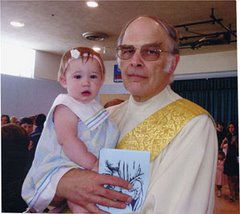Matthew 26:14 - 27:66
We’ve just heard the Passion of Jesus read, according to the Gospel of Matthew. Palm Sunday is a rough ride. We begin with Jesus being welcomed by crowds of joyful people and end with his death on the cross. That Jesus died on a cross is a fact. But each Gospel account of that death is a little different, sometimes even contradicting other accounts. We could spend a lot of time, as many have done, “harmonizing” the gospels so that we could have one story which ironed out the discrepancies and contradictions. But if we remember that the gospel writers were writing theology, not history, we can then read the gospels the way they were meant to be read.
Matthew’s account builds on Mark’s. Matthew, Mark and Luke, but not John, describe the tearing of the veil of the sanctuary in the temple. Matthew goes on to describe six other phenomena not seen in the other gospels. These are: the earth quaked; rocks were splint; tombs were opened; the bodies of many saints who had fallen asleep were raised; and coming forth from their tombs after his resurrection, they appeared to many. Matthew is telling us in a few short words, about the consequences of Jesus’ death.
First, the Jewish people believed that God was with them in a special way; he dwelt in the sanctuary of the temple. It’s sort of the same kind of idea we Catholics have about the Eucharist; we believe Jesus is not limited in space or time but is present in a special way in the Bread and Wine after the solemn consecration by a priest. In Jesus’ time priests who went into the sanctuary had to go through elaborate purification rituals and their access was severely limited. Sometimes priests would receive revelations, such as Zachary, the father of John the Baptist did. But the temple veil was torn down the middle; God no longer was symbolically separated from his people! He can be approached by everyone; you don’t need a priest to make intercession for you.
The earth quaked and rocks were split. Earthquakes are very frightening, more so than many other dangerous natural phenomena -- because we expect the earth to be stable. And the same is true of rocks. They don’t split spontaneously. And the people of Jesus’ time always blamed supernatural powers for earthquakes. Only a God can shake the earth, and only a God can split a rock. As God rushes into the world from the temple, these things happen. Matthew wants us to know that the death of Jesus unleashes something new. The world will never be the same. And Matthew in a way speaks to us about that idea that goes all through his gospel; Jesus is God with us; he is Emmanuel, he is the one who says “I will be with you always”. And he is in the earthquake, in the split rocks -- wherever great power is manifest.
And tombs were opened. The one who splits rocks and shakes the earth opens the tombs -- not of everyone, but apparently of the holy people. And notice that Matthew does not say the holy people were raised, he says the bodies of the holy people were raised. It is a peculiar idea we Christians have about our ultimate destiny; our bodies will be raised along with our spirits. Many religions believe our spirits live on in some way, but we believe our bodies will be raised, even if you are cremated; even if there is nothing left to raise. Matthew is remembering the prophet Ezechiel, who has God promising to raise his people; who has a vision of bones being put together and covered with flesh and given life.
And finally Matthew tells us “...and coming from their tombs after his resurrection they appeared to many”. Notice that their tombs were opened and their bodies raised happens when Jesus dies; and the raised saints come forth after his resurrection and appear to many. In other words, the power of Jesus’ death raises the good people who have been waiting; and the power of his resurrection, his conquering death, releases them also. Matthew wants us perhaps to see that while Jesus conquers death, through Jesus those who have lived good lives in the past have also conquered death and after His resurrection they manifested themselves to many; they continue to be witnesses to His resurrection.
Perhaps the foremost witness is Mary, who down through the ages has appeared time and time again, not just to Christiains but to others. But other saints have appeared as well, probably a lot more often than we hear about. Sister Caterina Capitana was dying of complications of stomach cancer and had a vision of Pope John XXIII three years after his death, and rapidly regained her health. That was the miracle that led to his beatification. And in our resurrected bodies who knows where God will send us to participate in granting his gifts to people, or perhaps admonishing them to avoid a course of action as Padre Pio is said to have done?
God is with us; God’s power cannot be resisted by anything; God can and does raise the bodies of the dead, and all of this stems from the irresistible power of Jesus’ death. So pray today for faith, and be grateful for what God has done for his people.



































